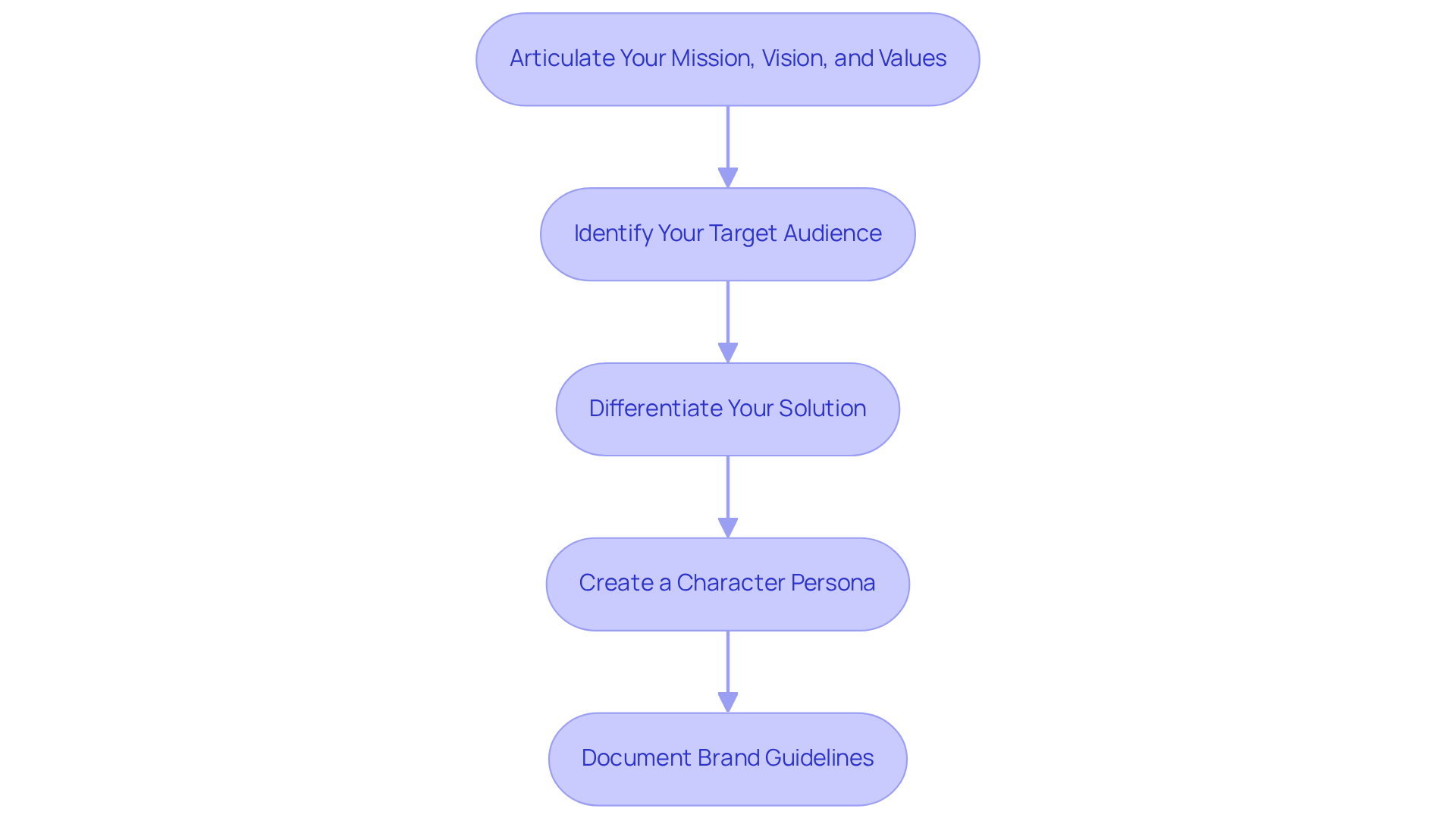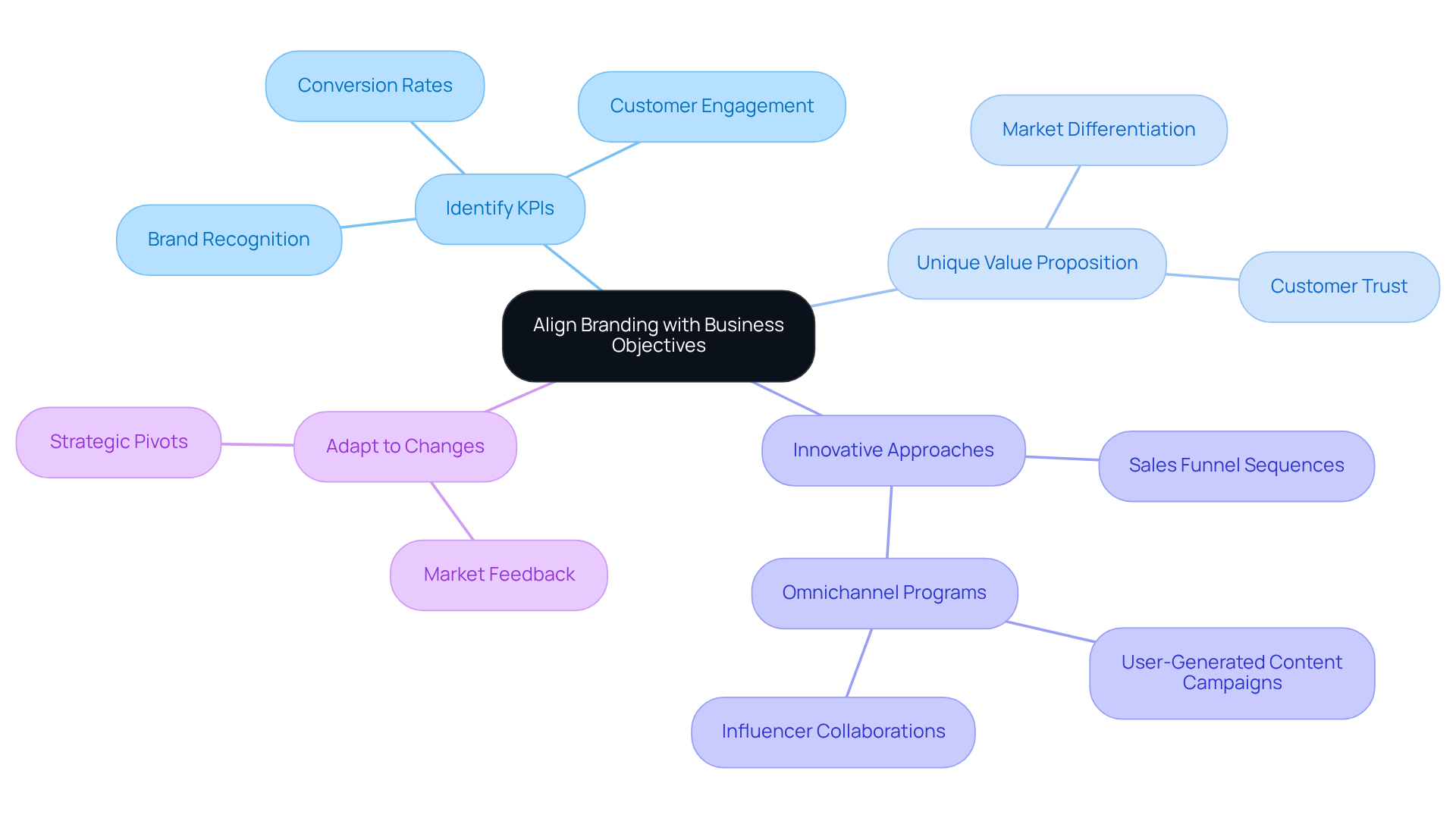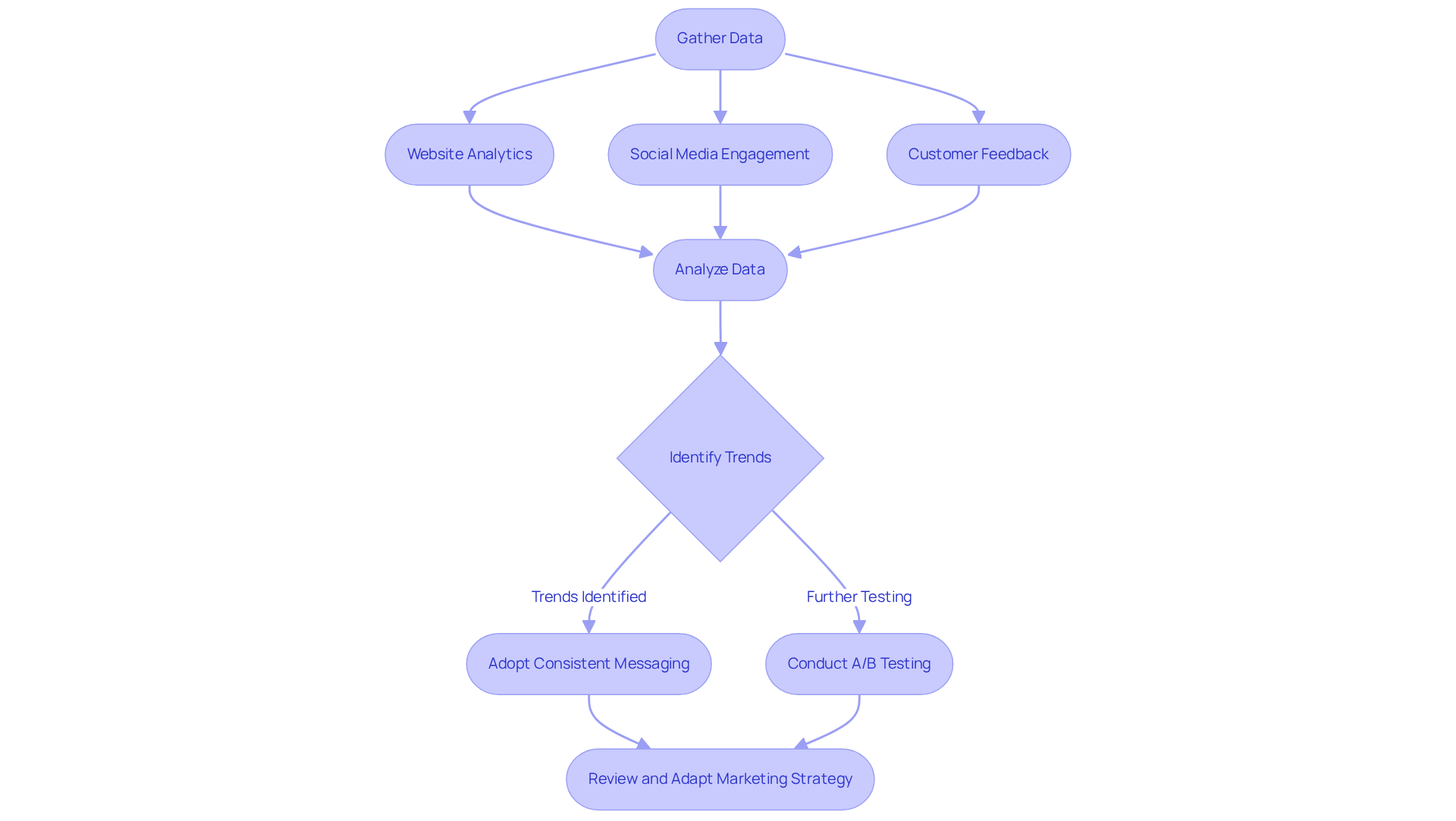Overview
The article highlights a common struggle for tech startups: the challenge of maintaining a cohesive brand identity. This issue can often lead to confusion among customers and a diluted market presence. By defining brand identity, aligning branding with business objectives, ensuring consistency across digital platforms, and utilizing data-driven insights for brand refinement, startups can overcome these hurdles.
Each of these strategies is supported by practical steps and examples, showcasing how a well-defined and consistently communicated brand can significantly enhance market positioning, foster customer loyalty, and drive overall business success.
Remember, you are not alone in this journey; many founders have faced similar challenges and found strength in a supportive community. Together, we can navigate the complexities of branding and create something truly impactful.
Introduction
In the fast-paced world of technology startups, establishing a strong brand identity is not just beneficial—it's essential for survival. Many founders find themselves grappling with the challenge of creating a cohesive brand image that resonates across various platforms and aligns with their business objectives. This struggle can lead to feelings of frustration and uncertainty, as they strive to carve out their niche in a competitive landscape. Understanding the core elements of branding can significantly enhance their market presence and foster customer loyalty.
So, how can tech startups effectively navigate this complex landscape? By focusing on branding, they can ensure their message remains consistent, relevant, and impactful, ultimately guiding them toward success.
Define Your Brand Identity
Defining your identity begins with a heartfelt expression of your mission, vision, and core values. It's essential to address pivotal questions such as: What problem does your startup seek to solve? Who is your target audience? What makes your solution ? These foundational elements will help you cultivate an on-brand persona that genuinely captures your startup's essence, guiding your messaging, visual identity, and overall strategy. For instance, if your startup emphasizes sustainability, your identity should resonate with eco-friendly values, reflected in your logo, color palette, and communication style. To ensure an on-brand approach across all platforms and touchpoints, it’s vital to document these elements in a comprehensive identity guideline. This approach not only fortifies your identity but also enhances your startup's chances of thriving in a competitive landscape.
Steps to Define Your Brand Identity:
- Articulate Your Mission, Vision, and Values: Clearly define what your startup stands for, embracing your unique journey.
- Identify Your Target Audience: Take the time to understand who you are serving and what their needs are.
- Differentiate Your Solution: Shine a light on what makes your offering unique in the market, celebrating your distinctiveness.
- Create a Character Persona: Develop a figure that embodies your company's traits, fostering connection and relatability.
- Document Brand Guidelines: Ensure consistency in messaging and visuals across all platforms, creating a cohesive narrative.
By implementing these steps and focusing on design-driven strategies, you can enhance your brand's marketability through RODD strategies, ultimately nurturing increased customer loyalty and improved market positioning.

Align Branding with Business Objectives
To effectively align your identity with business objectives, it’s crucial to first identify your key performance indicators (KPIs) and overarching goals. Many founders face the challenge of ensuring their branding is on-brand and effectively communicates . For instance, if your aim is to increase market share, your messaging must highlight how your product or service stands out from competitors.
You might consider innovative approaches like RNO1's Ryde initiative, which focuses on:
- Expanding omnichannel brand ambassador programs through national user-generated content campaigns
- Creating effective sales funnel sequences
This can significantly enhance your e-commerce engagement via influencer collaborations.
It’s essential to consistently assess your on-brand approach to ensure it adapts to evolving business objectives. This may involve making adjustments to your messaging or visual identity based on market feedback or shifts in your strategy. For example, if your startup pivots to focus on a new technology, your identity should reflect this change to maintain relevance and clarity.
Remember, maintaining an on-brand image can lead to a 10-20% increase in revenue, highlighting the importance of a cohesive approach that truly resonates with your target audience. By nurturing this alignment, you can foster a brand that not only stands out but also connects deeply with those you aim to serve.

Ensure Consistency Across Digital Touchpoints
To achieve onbrand consistency across your digital touchpoints is a challenge many tech startup founders face. It can be disheartening to see your brand’s message diluted due to inconsistent logo usage, color schemes, typography, and tone of voice. This inconsistency not only creates confusion but can also weaken trust among potential clients, impacting their perception of your onbrand image. Imagine if your social media updates are not onbrand, showcasing different logos or color palettes than your website—this could lead to uncertainty and a lack of recognition, which is detrimental in today’s competitive landscape.
At RNO1, we understand the pain points of navigating these challenges. We believe that developing comprehensive guidelines is essential for nurturing a strong onbrand identity. Our approach fuels the growth of purpose-driven brands through strategic activation and design empowerment. We ensure that these guidelines are accessible to all team members and partners involved in content creation and marketing efforts, fostering an onbrand presence.
Regular audits of your digital presence are crucial. By identifying inconsistencies and areas needing improvement, you can take proactive steps to enhance your brand’s onbrand coherence. Utilizing digital asset management systems can centralize promotional assets, making it easier for everyone to access and use the correct materials. This way, you can build an onbrand solid foundation of trust and recognition with your audience.
RNO1’s offerings, such as Brand Strategy & Experience Guidelines and Identity Design, not only improve recognition but also cultivate loyalty among clients over time. By prioritizing in your identity, you can establish enduring relationships with your clients. Authenticity is vital when choosing which companies to endorse and support, and we are here to help you navigate this journey with care and expertise.
Utilize Data-Driven Insights for Brand Refinement
To effectively harness data-driven insights for enhancing your onbrand strategy, it's essential to start by gathering information on client interactions across various channels. This includes:
- Website analytics
- Social media engagement metrics
- Direct customer feedback
By examining this data, you can uncover trends and patterns that greatly inform your onbrand marketing approach. For instance, if analytics reveal that a certain messaging style resonates with your audience, it may be wise to adopt this onbrand style consistently across all platforms. Additionally, employing A/B testing for different marketing elements—like logos or taglines—can offer valuable insights into what resonates most with your target market.
Regularly reviewing and adapting your marketing strategy to keep it onbrand based on these insights is crucial for maintaining relevance and appeal in a competitive landscape. Organizations that implement onbrand data-driven strategies not only enhance client retention but also boost overall loyalty and profitability. In fact, data-driven organizations are 23 times more likely to acquire customers, underscoring of data in marketing efforts. A compelling example is Slevomat, which saw a 23% increase in sales after implementing the Keboola data innovation platform, showcasing the real benefits of data-driven decision-making.
Moreover, RNO1's Ryde initiative illustrates how creative approaches to expanding omnichannel brand ambassador programs can enhance e-commerce interaction through influencer collaborations. By integrating these practices, tech startups can significantly elevate their branding strategies. Remember, you’re not alone in this journey; embracing data insights can lead to remarkable growth and connection with your audience.

Conclusion
Defining and maintaining a strong brand identity can feel overwhelming for tech startups striving to stand out in a crowded marketplace. It’s not just about having a logo or a catchy tagline; establishing a clear mission, vision, and set of values is essential. This foundation shapes your brand’s persona and guides its messaging and visual representation. When these elements are thoughtfully articulated, they create a cohesive identity that truly resonates with your target audience, setting you apart from competitors.
Many startups grapple with aligning their branding with business objectives, ensuring consistency across digital touchpoints, and utilizing data-driven insights for brand refinement. Each of these elements is crucial in fostering a strong on-brand presence. For example, when your branding aligns with your business goals, it enhances the communication of your unique value proposition. Consistency across all platforms builds trust and recognition, which is vital for establishing lasting relationships. Moreover, leveraging data provides valuable insights that can refine your branding strategies and improve customer engagement, making your efforts more effective.
In closing, the importance of a well-defined and consistent brand identity for tech startups cannot be overstated. By embracing these strategies, you not only enhance your market positioning but also cultivate meaningful connections with your audience. Adopting a holistic and data-informed approach empowers you to navigate the complexities of branding, ultimately driving growth and success in your industry. Remember, you are not alone on this journey; together, we can build a brand that reflects your vision and values, creating a lasting impact.
Frequently Asked Questions
What is the first step in defining a brand identity?
The first step is to articulate your mission, vision, and core values, clearly defining what your startup stands for.
Why is it important to identify your target audience?
Identifying your target audience is crucial because it helps you understand who you are serving and what their needs are, allowing you to tailor your messaging and offerings accordingly.
How can a startup differentiate its solution in the market?
A startup can differentiate its solution by highlighting what makes its offering unique compared to competitors, celebrating its distinctiveness.
What is a character persona and why is it important?
A character persona is a figure that embodies your company's traits, fostering connection and relatability with your audience, which is important for building a strong brand identity.
What should be included in brand guidelines?
Brand guidelines should document elements such as messaging and visuals to ensure consistency across all platforms, creating a cohesive narrative for the brand.
How does defining a brand identity impact a startup's success?
Defining a brand identity fortifies the startup's essence and enhances its chances of thriving in a competitive landscape by guiding its messaging, visual identity, and overall strategy.
What role do design-driven strategies play in brand identity?
Design-driven strategies enhance a brand's marketability, which can lead to increased customer loyalty and improved market positioning.




